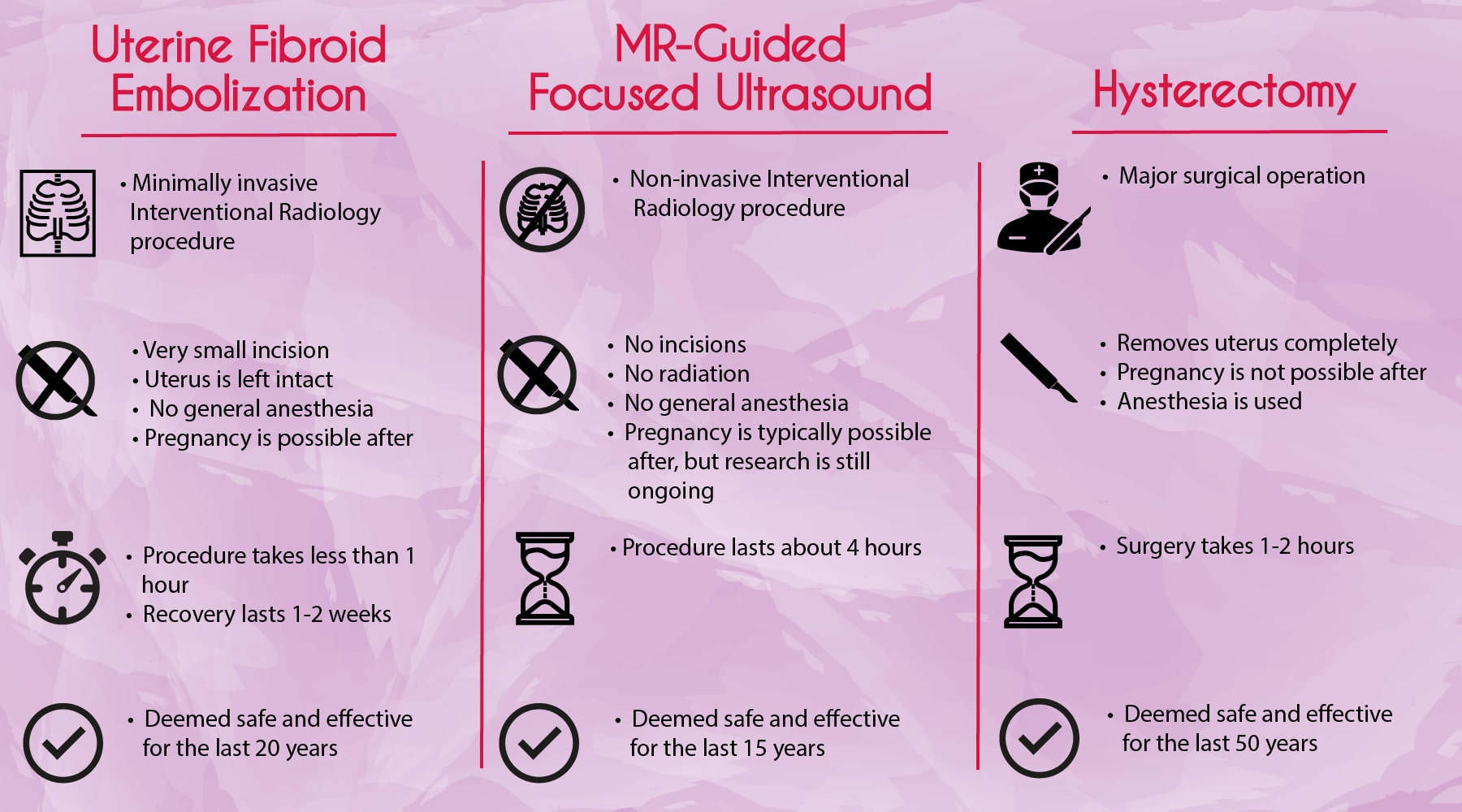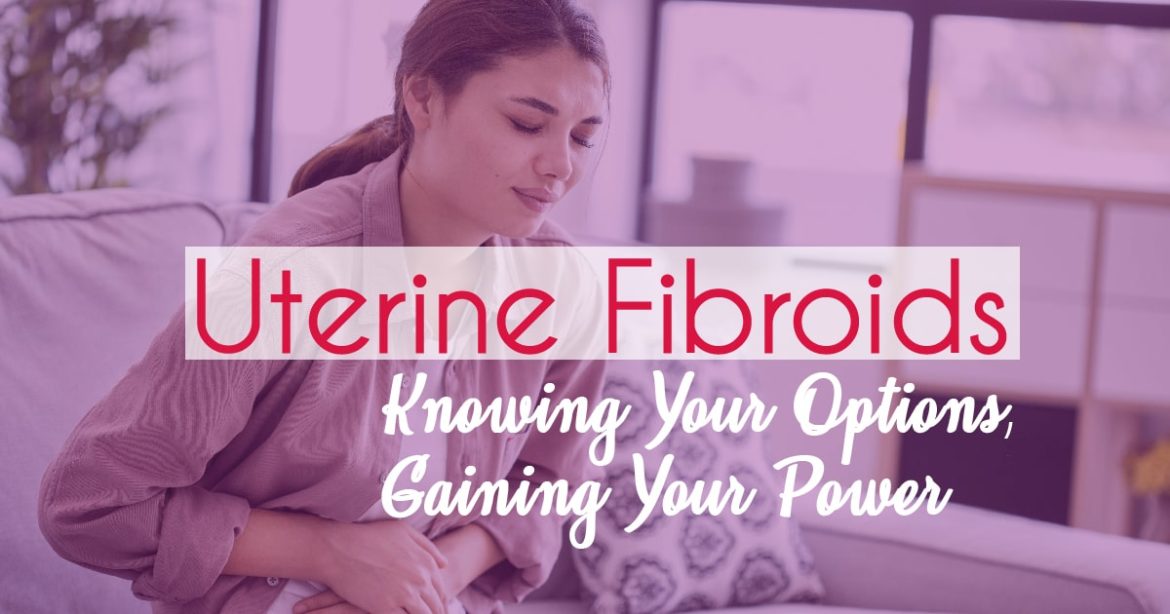Do you suffer from heavy menstrual periods and abdominal pain? Do your periods seem to last longer than normal? Have you made changes to your life because of your menstrual cycle? If you answered “yes” to any of these questions, you may have uterine fibroids.
At UVA Interventional Radiology, we want you to know that you have uterus-preserving treatment options. UVA Interventional Radiologists perform short, minimally and non-invasive procedures like focused ultrasound and uterine fibroid embolization to treat uterine fibroids without the removal of your uterus.
What Are Uterine Fibroids?
Uterine fibroids are a type of non-cancerous growth that form in the muscle cells of the uterus. Women may have one fibroid or many fibroids, which can range in size from a tiny seed to a large bulky mass the size of a grapefruit. Fibroids are often found incidentally during routine pelvic exams. To confirm that you have uterine fibroids, your doctor may order further imaging or lab tests.
20-40% of premenopausal women have fibroids (some doctors estimate this number is higher). However, only 5-10% of women with fibroids actually develop symptoms. Fibroids do not spread to other parts of the body and are not dangerous, but when they do exhibit symptoms they can sometimes be severe.
Since most women with fibroids don’t experience any symptoms, it can be easy to overlook the severity of this condition. Nevertheless, women who do experience symptoms often have to make drastic lifestyle changes to deal with them. Having serious or unpredictable menstrual cycles can also lead women to have feelings of discomfort, nervousness, isolation, and shame. Perhaps the most challenging aspect of this condition is the way fibroid symptoms affect a woman’s peace of mind.
Symptoms
Uterine fibroids can lead to one or more of the following symptoms:
- Heavy and/or painful menstrual periods
- Uterine or pelvic pressure
- Abdominal enlargement
- Pain during intercourse
- Frequent urination
- Constipation
- Anemia
- Pain in the back of the legs
- Sometimes fertility issues
Knowing Your Options, Gaining Your Power
Uterine fibroids can cause many women to feel powerless and limited, planning their lives around painful, heavy menstrual bleeding. While no single treatment option will work for all women, knowing your options for treatment and talking with your doctor can empower you to make the right decisions for your health.
Some women who have fibroids but no symptoms may decide that watchful waiting is the best option for them. For other women with fibroids, medications or a hysterectomy (removal of the uterus) may be the most viable options. However, for some women, the following minimally or non-invasive, uterus-preserving procedures provided by UVA Interventional Radiology may be the best option.

1. MR-Guided Focused Ultrasound
This procedure (also called high-intensity focused ultrasound or HI-FU) is performed while the patient is inside an MRI scanner so that doctors can locate and visualize the exact location of the uterine fibroids. An ultrasound transducer then uses concentrated, high-intensity ultrasonic pulses to heat and destroy fibroids without making any incisions to the body.
You may have an intravenous line placed into your arms that will give you medication for relaxation and pain throughout the procedure. Focused ultrasound takes around 4 hours, and the recovery time lasts only one day. While this procedure may not be right for those with many fibroids or large fibroids, it may be an alternative for those with mild fibroids that cause pain.
2. Uterine Fibroid Embolization (UFE)
During uterine fibroid embolization (UFE) (also called Uterine Artery Embolization, or UAE), an interventional radiologist uses fluoroscopy to see inside the patient. Fluoroscopy provides a live-stream x-ray video to help doctors guide their instruments precisely to the fibroids as they perform the procedure.
UFE begins with a small incision, usually near the groin, allowing the doctor access to the femoral artery in the thigh. Next, the doctor inserts a catheter into the artery, guiding it to the fibroid being treated. Once in position at the base of the blood vessel that feeds the fibroid, the catheter is used to inject small beads into the blood vessel, causing the vein to clot. The beads block the flow of blood to the fibroid, causing it to shrink and die. This process is repeated until all the blood vessels to all the fibroids have been successfully blocked. At that point, the doctor removes the catheter and places a bandage over the small incision.
Over the course of a few weeks, the painful fibroid-induced symptoms will begin to go away. A follow-up appointment with the interventional radiologist is usually scheduled for 1-2 weeks after the procedure.
Treating Uterine Fibroids at UVA Interventional Radiology
At UVA Interventional Radiology, we are proud to offer minimally invasive and non-invasive image-guided treatments for fibroids. If you are suffering from painful uterine fibroids, talk to your doctor about these treatment options or click here to learn more about how uterine fibroids are treated at UVA.



